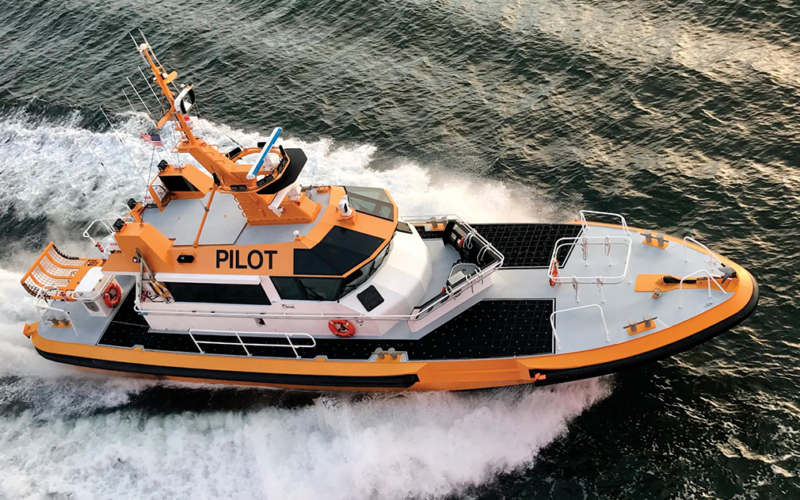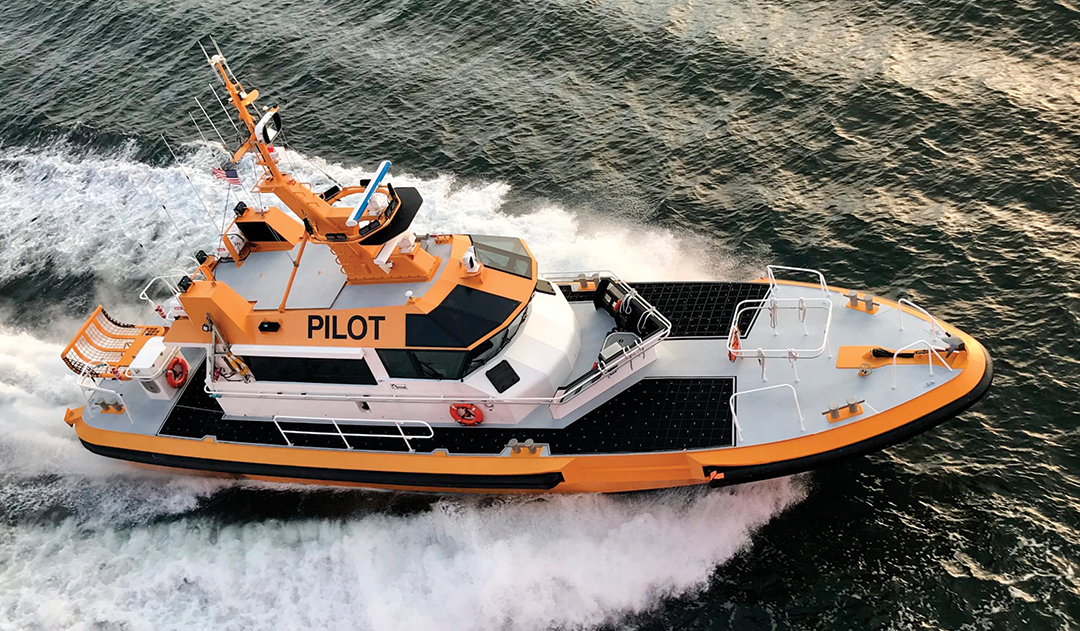
Pilots and the highly specialized boats they depend on have occupied a unique position in the maritime sector since the days of sail. Motorized pilot boats, introduced around 1900, relied on traditional displacement hulls with a top speed of around 10 knots and remained in service into the late 1990’s on the West Coast. They were finally replaced by the spectacular high-speed designs that are now essential in container ports to ensure the accelerated rate of shipping traffic.
This breakthrough was based on pioneering design work in New England that had been the center of research for high-performance boats for over a century. By the 1950’s, several designers had proved that increasing the angle of deadrise improved the motion of loaning hulls in a seaway. This led to the radical deep-V hull shape that could maintain planing speed in rough water with far more comfort.
By 1960, yacht designer and naval architect Raymond Hunt, of New Bedford, Ma., began drawing plans for deep-V motor yachts for owners who wanted to sportfish, cruise at speed, or race offshore.
Almost two decades later, the design caught the attention of the Delaware Pilots, but these first four deep-V pilot boats were built in steel which limited their performance. It was the Charleston Pilots which ordered two 55-foot aluminum boats from Gladding-Hearn shipyard in Somerset, Ma., in 1980.
Those lightweight 55-foot twin-screw launches could cruise comfortably at well over 20 knots with only 875-hp and were very stable coming alongside ships moving at 12-15 knots in a seaway. They realized the full potential of the new hull form and dramatically changed the way pilotage worked around the world, Winn Willard, current president of Ray Hunt Design, explained.

Hunt continues the partnership with Peter Duclos, the second-generation president of Gladding-Hearn, which since opening in 1955 has delivered a total of 90 pilot boats – 40-72 feet in length – for pilots from the Great Lakes to the Gulf of Mexico. They include over 40 of the popular 52-56-foot Chesapeake Class. The latest version was ordered by the Association of Maryland Pilots, which already run four of the boats.
The fifth for delivery later this year has a 16.8-foot beam, a 4.8-foot draft and is powered by twin Volvo Penta D16, EPA Tier 3-certified diesels, each producing 641 Bhp at 1800 rpm. Top speed is predicted to be over 26 knots with 5-blade Bruntons nibral propellers, ZF500-1-A gear boxes, and a Humphree Interceptor trim control system.
The wheelhouse is outfitted with five NorSap shock-mitigating seats and three weathertight doors. The exterior is surrounded by a Harken TR-31 safety rail system with heated decks and handrails. There are hinged boarding platforms on the roof and a hydraulic-powered J-Basket rescue system on the stern. The Chesapeake is also available with a hull optimized for the Volvo IPS pod propulsion, for a top speed of 30 knots and a service speed of 25.
Hunt also has a smaller RIB-type design, the Resilient Class, at 35-40 feet in length overall and a 13-foot beam including the foam collar. The hull features a steep 24-degree dead-rise at the transom that increases to a very fine entry forward. Gladding-Hearn offers this with twin Cox CXO300 300 hp diesel outboards, for a top speed of over 35 knots with Zipwake interceptor trim-control tabs.
It took another 20 years for the fast offshore pilot boat to make its debut in the Pacific Northwest, where prevailing winds and swells build up over 5,000 miles of open ocean and every ship must navigate an unpredictable river mouth.
Those conditions require annual dredging to maintain the depth and may lead to all shipping lanes being closed for several days during winter storms. This is a crucial issue for the Columbia Bar Pilots, working at the most challenging river bar on the coast with ship movements around the clock, every day of the year. They rely on their veteran 80-foot boat Peacock – a full displacement 12-knot design.
During the late 1990’s, the pilots began modernizing their transportation system not with a fast boat but with an Agusta Westlund 109 helicopter, becoming the first pilot service in the nation to take to the air.
Only then did they begin the search for a high-speed, self-righting boat that could handle winds of 75 knots and swells on the bar of up to 30 feet – conditions that would effectively ground the helo.
After surveying pilot groups with similar conditions in several countries, the three pilots on the search committee decided that the only boats that came close to meeting this standard were operated by the Nederlands Loodswezen B.V. (Netherlands Pilotage Service) and designed in Scotland by Camarc.
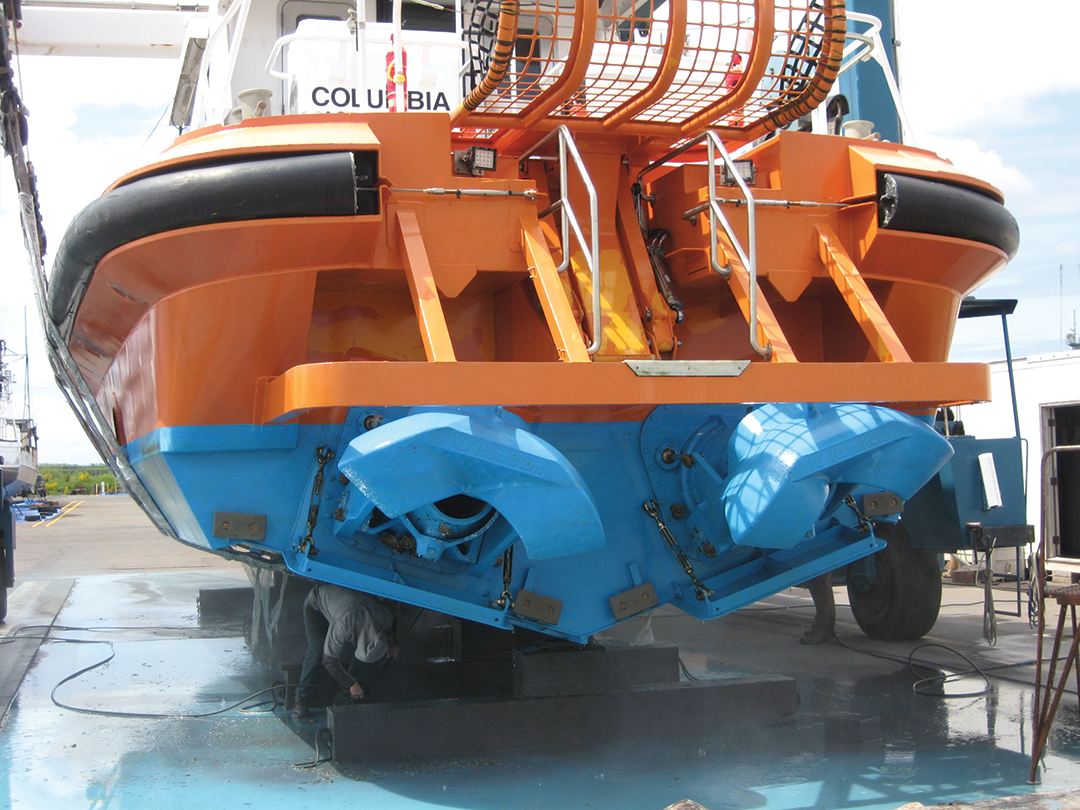
A team of Columbia River pilots travelled to Rotterdam and were able to test a 63-foot Camarc high-performance boat on the North Sea at 25 knots, observing how it approached a ship on a lee shore. The test craft was part of the large fleet that is needed for 460 Dutch pilots to service 90,000 sea-going vessels a year.
The Oregon-based pilots returned to Astoria, confident that Alistair Cameron, the founder of Camarc, was the first choice to design their new boat. The bar pilots group subsequently voted in favor of this finding, and the contract for a 72-foot aluminum boat was awarded to the Scottish company in 1999, explained bar pilot Captain Robert Johnson.
To suit the task, Cameron’s staff developed a new deep-V double-chine hull with the ability to come alongside ships and fall off in harsh weather, routinely handle large breaking waves, and self-right from a capsize. Ensuring continued operation after a capsize, many additional features are required including a watertight pilothouse, dampers on all ventilation ducts, reinforced engine mounts, and special fuel-tank fittings.
More consultation followed over details such as the deck layout, the Man OverBoard recovery systems, and handrail positioning. Cameron recommended the Pop Sure fender system consisting of a full-length flexible pipe retained by a tensioned internal wire, a fixture on all their heavy-weather designs.
Kvichak Marine Industries of Seattle, with a record of producing rugged aluminum fishing, work boats and catamaran ferries, delivered Chinook, the Camarc prototype, in 2000. The boat’s performance soon began to attract attention from other pilots’ groups, which led to orders for Kvichak from the Sabine Pilots in Port Arthur, Texas, the Savannah Pilot Association in Georgia and the Houston Pilots in Texas.
The design of the pilothouse evolved during this period, improving the bridge layout and increasing visibility. In 2007, when the Bar Pilots ordered a second boat, Columbia, this upgrade gave the house a contemporary style, with tinted armored glass surrounding the helmsman. The standard power plant was the new MTU MDEC 16V2000 diesel rated for 1410 BHP at 2100 rpm, with ZF transmissions driving Hamilton 651 waterjets. That propulsion combo produced cruise speeds close to 25 knots with a top speed up to 30. A sister ship, Astoria, arrived in 2018, after which Chinook was sold to B.C. Pilots.
By 2020, Kvichak had been bought out by Vigor Industrial, which operated the largest shipyards in the northwest. They acquired a former yacht building factory in Vancouver, Wash. to build two customized 56-foot Camarc boats, Angels Pilot and Angels Navigator, for the Port of Los Angeles Pilot Service.
Ironically, another experienced Seattle yard, Snow & Company, then recognized the opportunity to expand and bid for jobs like this by leasing the former Kvichak property on the Seattle Ship Canal. Snow quickly won an order for a 64-foot Camarc launch for the Savannah Pilots, followed by the 72-foot Golden Gate for the San Francisco Bar pilots, delivered last summer at a cost of over $9 million.
This modified design featured some major changes from the previous boats, starting with Camarc’s new hull shape that integrates a vertical stem into the bow, and a Humphree active ride control system on the stern. It is also one of the first craft of its type with Tier 4 engines, twin MAN 13-liter V12’s with a superior power-to-weight ratio. They are each fitted with a pair of MAN’s compact SCR units and produce 1200 hp, turning Hamilton HTX52 waterjets for a cruise speed of 24 knots and top speed of 30 knots.
Other notable equipment included fenders supplied by Netherlands-based Poly Marine Fender System, which casts each order individually from advanced synthetics.
Snow is currently building a pair of Camarc 50 footers for the Crescent River Port Pilots’ Association in Louisiana. These are powered with twin Volvo Penta 800 hp D13-800 EPA Tier 3 marine diesels and twin Hamilton Jet HJ403 waterjets to reach a cruise speed of 32 knots.
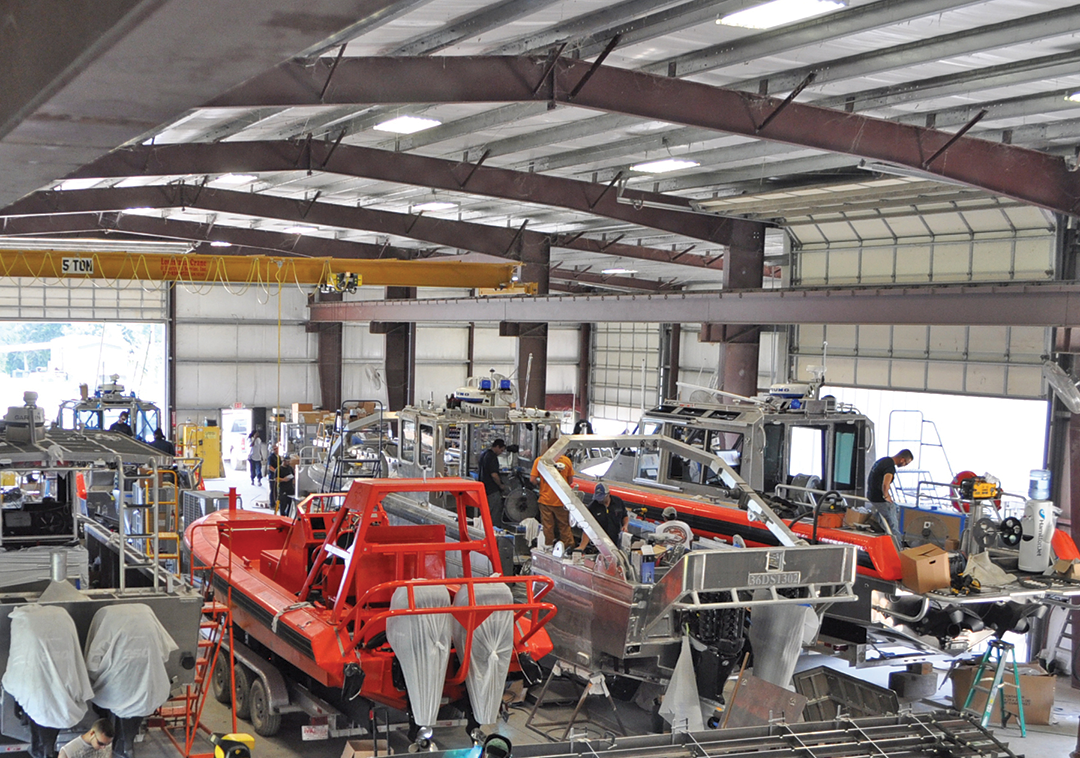
On the Gulf Coast, Louisiana-headquartered Metal Shark is a diversified shipbuilder with over 500 employees, giving it the ability to construct patrol boats up to 165’ long, large catamaran ferries, and hundreds of smaller aluminum craft for government and commercial operators with output that includes pilot, crew, and fire boats based on standard Defiant hulls up to 85 feet, designed by the company’s own technical team.
This is the basis for its 45-, 55- and 64-foot pilot boats, with the middle size filling the most recent order from the Pascagoula Bar Pilots Association.
For all pilot boat clients, Metal Shark pairs the proven hull form with flat, non-skid decks from bow to stern, pilot-specific fendering systems, plus stern corners and bow with a gentle radius to allow easy underway separation from ships.
Safety rails and grab handles are carefully placed to meet the needs of the operators. In this case, the foredeck features integrated port, starboard, and forward stairways leading to two deployable platforms.
A recent upgrade is the inclusion of the company’s innovative pillarless pilothouse windows combined with a reverse-raked windshield to deliver maximum all-round visibility.
In addition, a panoramic skylight array provides an unobstructed upwards view while a second row of windows below the belt line provides a downward view from the helm.
To meet the client’s performance requirements, Metal Shark equipped the Singing River Island with twin 803-horsepower Cat C18 engines turning Michigan Wheel 34-inch diameter nibral four-blade propellers through Twin Disc MGX5146A 1.961 gears. This combination delivers a cruise speed in the 25-knot range and a top speed approaching 30-knots. An 800-gallon fuel capacity allows for a cruise speed range of approximately 280 nautical miles.
“Metal Shark has succeeded in combining quality and comfort,” said the Pascagoula Pilot’s Capt. Walter Gautier. “This vessel is proving daily to be a safe and pilot-friendly platform for transfers at sea.”
All these designers and builders go to great lengths to accommodate the specific needs of different pilots’ groups, but there is one major feature that is not optional: the hull material with aluminum the choice for the vast majority of fast commercial vessels in U.S. waters, from RIBs to giant catamarans.
But in the UK, northern Europe, and Australia over 80 percent of all pilot vessels are built in GRP (fiberglass).
In England, several yards specialize in heavy-duty fiberglass hulls, like Goodchild Marine Services with several molds 41- to 58-feet long. Those boats are designed by French naval architects Pantocarene with their unique wave-piercing bow.
These hulls can be laminated quickly and at a reasonable cost. Customers typically operate several identical boats: Associated British Ports recently ordered nine of the 58 footers for use around the British Isles. Nordlund Boat Company, a well-established builder of custom fiberglass motor yachts based in Tacoma, Wa., has successfully built four 63-foot pilot boats, two in 2000 for Pacific Pilots of B.C. and two between 2018-20 for Jacobsen Pilot Service at the Port of Long Beach, Ca.
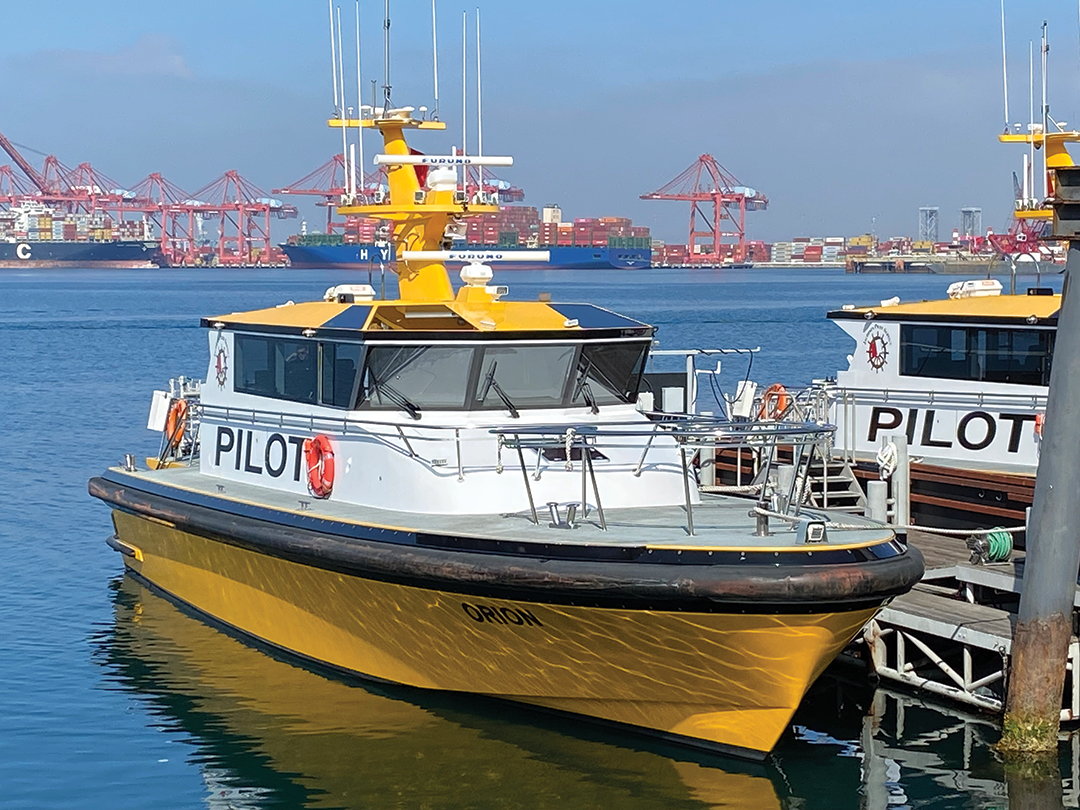
Polaris III and Orion were designed for Jacobsen by Tim Nolan with a sophisticated underwater shape.
Tom Jacobsen, president of Jacobsen Pilot Service, wanted a 25-knot average speed, reduced maintenance costs, and high efficiency. Power comes from twin Caterpillar C18 1,193 kW engines driving a pair of Hamilton Jets with stability improved through passive anti-roll tanks located in the aft outboard corners of the hull. They help minimize roll and pitch when not underway and empty as the boat accelerates.
To ensure self-righting after a capsize, the deckhouse and mast are made from lightweight carbon fiber skins with a foam core “sandwich.” The composite foam core hull meets ABS requirements for high-speed vessels by infusing in a vacuum-bagged mold.
The Poly Marine Service fender system can withstand repeated impacts while reducing the shock to passengers and delicate electronic equipment. The hull laminate absorbs shocks and reduces engine noise and vibration. The deck layout includes a Harken TR31 track and safety rail system around the house.
“We made the Puget Sound and Long Beach Pilot Boats super quiet and used comfortable high-end seating to reduce fatigue for the pilots as well as for the boat operator and crew,” said Nolan.
(See the December 2023 issue of Professional Mariner for an in-depth look at Jacobsen Pilot Service).
The Laurentian Pilotage Authority (LPA), based in Montreal, Canada, provides pilotage services in Canadian waters and was seeking a fast pilot boat that could stand up to the region’s severe winter weather.
They turned to Estonia-headquartered Baltic Workboats for the design and construction of a 17-meter ice-capable aluminum pilot boat that was delivered to the LPA last year.
The design of the Shipeku was based on the company’s well-established workboat line that has produced well over 200 versatile workboats to customers around the world over the last 20 years, and specifically on a 56-foot pilot boat they delivered to a Polish pilot service at the end of 2020.
“This new version features our standard patented wave-piercing bow that reduces pitching motion, with beam increased to 5.6 meters [18.3 feet] with extra ice frames and reinforcements to enable it to work in 4 – 6 inches of ice,” said Carl Mahler, head of sales for Baltic Workboats US in Coral Gables, Fl.
Power comes from twin Volvo Penta Tier 3, 700 hp D-13 engines, driving fixed-pitch propellers via ZF gearboxes that give it a cruising speed of 25 knots.
The watertight pilothouse makes it self-righting, with seating for one coxswain and six passengers, firefighting gear, and two man-overboard rescue systems.
The remote monitoring system is another feature that sets the Shipeku apart.
“There aren’t many switches in the wheelhouse,” Mahler said. “Everything is controlled through programmable logic controllers, which feed to a touchscreen in the wheelhouse.”
Jones Act craft like the Port Everglades pilot boat will be built under license by Lyman Morse Boatbuilding in Thomaston, Me., with recreational versions optionally built by Baltic Workboats in Estonia. •

